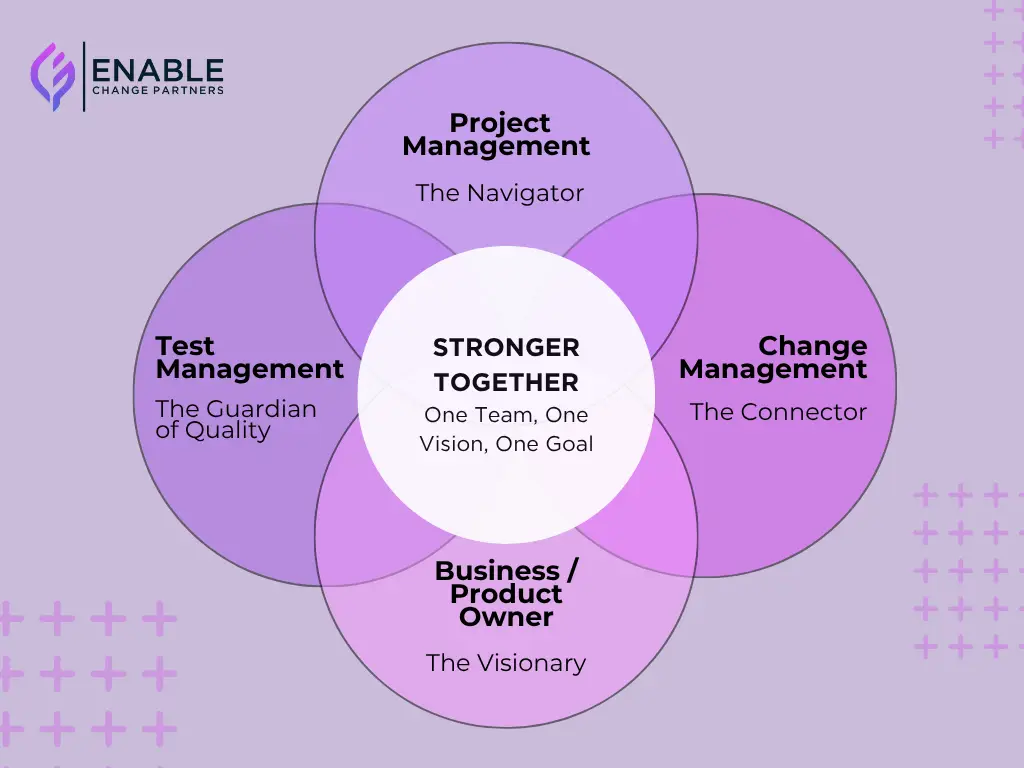In every successful technology project, there’s one constant that determines whether the outcome thrives or fails: relationships.
Not tools.
Not frameworks.
Not even budget or scope.
It’s the relationships between the people doing the work, the strength of the connections across disciplines. Project Management, Change Management, Test Management, and Business, determine how effectively we can deliver not just a system that works, but one that people are ready to use.
Technology projects are not just technical undertakings; they are deeply human endeavours. Systems can be built, tested, and deployed, but their success hinges on how well people understand, accept, and adopt them. That’s where collaboration, empathy, and shared accountability come in.

The Heart of the Project: Why Relationships Matter
At the center of every technology project sits a shared purpose: delivering value. But each function approaches that purpose from a slightly different lens.
Here’s how they show up, as people:
Project Managers are the navigators. They’re the calm voice in the storm, the ones who keep the ship steady when the waves rise. They juggle timelines, manage risks, and hold everyone accountable, but the best ones do more than that. They create clarity where there’s confusion and build trust when the pressure is on. They’re the people everyone looks to when decisions need to be made with confidence.
Change Managers are the connectors, the heart and soul of transformation. They sit at the intersection of people, process, technology, business, systems, environment, and everything in between. Without them, the project might deliver a system, but it rarely delivers change that sticks.
They are the bridge between the business and the people. They don’t just manage change, they make it human.
Change Managers get under the hood to understand what’s really happening. They listen deeply to uncover not just what’s being said, but what’s being felt. They work to understand what’s impacting their stakeholders day-to-day. How they think, how they feel, what motivates them, and what they need to move confidently through transition.
They help leaders see what their teams might not say out loud. They help project teams translate technical complexity into relatable meaning. And they create safe spaces for people to ask questions, voice concerns, and build confidence.
At their best, Change Managers are both empathetic and strategic. They blend psychology with communication, analytics with storytelling. They understand that successful change isn’t just about processes and plans. It’s about people trusting the journey and believing in the future state.
Test Managers are the guardians of quality. They bring structure and discipline to ensure what’s being delivered actually works. But beyond the scripts and the systems, great testers are problem-solvers and truth-tellers. They care about building confidence, not just that the system runs, but that the people using it can trust it.
Business and Product Owners are the visionaries and custodians. They represent the real world, the users, the customers, and the frontline. They remind the team what success looks like in practice, not just in theory. They are the anchor point for why the project exists in the first place. The best business owners are not just stakeholders; they are storytellers who bring the human impact of the change to life.
Each of these perspectives is essential. And when they operate together, with empathy and respect, the results are powerful.
That’s why relationships aren’t just “nice to have.” They’re the glue that turns a group of skilled individuals into a high-performing, purpose-driven team.
True collaboration happens when every function respects the other’s expertise, communicates openly, and aligns around the same vision of success.

The Four Pillars of Project Partnership
The Venn diagram provides a visual representation of how these disciplines overlap and depend on each other. Each circle represents a critical area of accountability, and the shared spaces represent the interdependencies that must be managed with intention.
Let’s explore each of these areas: their responsibilities, their overlaps, and how strong relationships make the difference.
A. Project Management – The Navigator
Focus: Governance, Schedule, Budget, Resourcing, Vendor & Contract Management
Project Managers are the navigators of the journey. They’re responsible for steering the ship, balancing time, cost, and scope, and keeping everyone aligned to milestones and deliverables.
But the most effective project managers know that their job isn’t just about managing plans. It’s about managing people. They build trust, they communicate with clarity, and they create an environment where everyone can do their best work.
A Project Manager who builds strong relationships across teams enables faster decision-making, reduces conflict, and ensures information flows freely. They are the connectors between vision and execution.
Key overlaps:
- With Change Management: aligning delivery milestones with engagement, training, and communication activities.
- With Test Management: ensuring testing timelines align with release schedules and resourcing.
- With Business/Product Owners: confirming that scope aligns to business outcomes and that decisions are made swiftly.
When project management becomes facilitation rather than enforcement, collaboration thrives.
B. Change Management – The Connector, the Heart and Soul
Focus: Engagement, Communications, Training, Business Readiness, Stakeholder Management
Change Managers are the connectors, the heart and soul of transformation. They sit at the intersection of people, process, technology, business, systems, environment, and everything in between. Without them, the project might deliver a system, but it rarely delivers change that lasts.
They are the bridge between the business and the people. They don’t just manage change; they make it human.
Change Managers get under the hood to understand what’s really happening. They listen deeply to uncover not just what’s being said, but what’s being felt. They work to understand what’s impacting their stakeholders day to day, how they think, how they feel, what motivates them, and what they need to move confidently through transition.
They help leaders see what their teams might not say out loud. They help project teams translate technical complexity into relatable meaning. And they create safe spaces for people to ask questions, voice concerns, and build confidence.
Key overlaps:
- With Project Management: aligning delivery milestones with communication, engagement, and readiness activities.
- With Business/Product Owners: ensuring that business messages, processes, and adoption plans reflect the real needs of employees.
- With Test Management: supporting business testers, ensuring that testing becomes both a validation exercise and a confidence-building experience.
Change Managers don’t just prepare people for what’s coming; they walk beside them through it. They make the unfamiliar familiar, the complex understandable, and the uncomfortable achievable. They turn uncertainty into progress.
C. Test Management – The Guardian of Quality
Focus: System & Integration Testing, Environments, Quality, User Acceptance Testing (UAT), Non-Functional Requirements (NFRs)
Test Managers ensure that what’s delivered actually works, technically, functionally, and practically. They bring structure and precision to chaos.
But the best Test Managers know that testing isn’t just about finding bugs. It’s about protecting trust. They work closely with developers, business users, and change teams to make sure the system isn’t just operational but reliable and intuitive.
Good testers collaborate with empathy. They understand that business users may be nervous or unfamiliar with testing, so they guide them patiently, helping them feel confident and involved.
Key overlaps:
- With Business/Product Owners: validating that business requirements are correctly translated into functionality.
- With Project Management: coordinating timelines for test cycles and readiness gates.
- With Change Management: ensuring business testers are supported and confident, and that testing reinforces belief in the new system.
Quality isn’t just about passing tests; it’s about building trust and assurance across every layer of the project.
D. Business / Product Owner – The Visionary and Custodian
Focus: Business Configuration, Target Operating Models, Reference Data, Operating Procedures, Staff & Union Consultation
The Business or Product Owner represents the heartbeat of the operation. They carry the business perspective, understanding how the system will impact real people and processes.
They help define what success truly looks like in the day-to-day work of teams. They balance strategy with practicality, ensuring that what’s being delivered will not only meet organisational goals but make sense for the people who use it.
Strong relationships between Business Owners and delivery teams make all the difference. When they are engaged and collaborative, the project has direction and meaning.
Key overlaps:
- With Project Management: confirming scope, priorities, and key sign-offs.
- With Change Management: aligning training, communication, and process adoption to business reality.
- With Test Management: overseeing UAT and confirming the system meets business needs before go-live.
The Business Owner brings everything back to purpose, reminding everyone why the project matters and who it ultimately serves.

The Overlaps: Where Collaboration Creates Magic
In the center of the Venn diagram, the circles overlap. This is where shared accountability and partnership live.
- Scope: jointly defined by Project Management, Business, and Change.
- Risk & Stakeholder Management: shared between all disciplines.
- Quality & Readiness: driven collectively by Test Management and Change.
Each overlap represents both opportunity and challenge.
If the project focuses too heavily on timelines without considering readiness, adoption suffers. If the change team drives engagement without understanding system constraints, expectations are misaligned. If test cycles are rushed, quality dips and confidence falters.
Strong relationships turn those potential friction points into learning opportunities. When functions understand each other’s pressures and priorities, they can work together to find balance.
Building a Culture of Partnership
Delivering a transformation requires more than coordination; it requires culture. A culture that values collaboration over control, dialogue over directives, and partnership over silos.
Here are the key principles that underpin that culture:
A. Shared Purpose
Remind every team member that everyone, regardless of function, is working toward the same outcome: a system that works and people who are ready to use it.
The moment we shift from “us vs them” to “we,” alignment starts to happen naturally.
B. Mutual Respect
Every discipline brings something vital. Project managers bring structure. Change managers bring empathy. Test managers bring rigor. Business owners bring vision.
When each group feels seen and respected for their contribution, psychological safety grows, and collaboration follows.
C. Transparency and Communication
Open communication is the lifeblood of effective relationships. That means sharing progress honestly, surfacing issues early, and keeping people in the loop.
Transparency builds trust, and trust fuels accountability.
D. Co-Design, Not Sequential Handoffs
Too often, projects run like relay races: design, then build, then test, then train. But successful transformation feels more like a dance.
When change managers are included in design conversations, they can anticipate impacts sooner. When testers are involved early, they shape realistic acceptance criteria. When business users are part of the build phase, solutions feel practical and familiar from the start.
Early collaboration prevents late-stage surprises.
E. Celebrate Collective Wins
When milestones are achieved, celebrate them together. Whether it’s a passed test cycle, a training milestone, or go-live itself, recognition reinforces unity.
Shared celebration builds shared pride.

System Ready, People Ready, Together
Every technology project has two critical dimensions:
- System Readiness – ensuring the solution works as designed.
- People Readiness – ensuring people are equipped, confident, and willing to use it.
These two must move together. A project can deploy a perfect system, but if people aren’t ready, adoption fails. Likewise, the best training program can’t compensate for a system that doesn’t function properly.
When all four disciplines work hand-in-hand, both readiness streams align. Testers validate the system. Change ensures users are confident. Project management keeps timing and governance tight. Business leads from the front.
That’s how you achieve not just delivery, but transformation.
Building Relationships that Last Beyond Go-Live
Strong project relationships don’t end at go-live. They evolve into lasting partnerships.
Teams that learn to collaborate through a complex project develop trust and rhythm that carry into future work. They know how each other thinks, communicates, and prioritises. That familiarity becomes an organisational advantage, a foundation for faster, smarter, and more resilient change in the future.
Technology and process can be replaced. Relationships cannot.

Harnessing the Strengths of Our People
Every project is an opportunity to harness the collective intelligence, creativity, and experience of our people.
When project managers, change leaders, testers, and business representatives come together, we combine logic with empathy, structure with flexibility, and process with purpose.
That combination is where innovation happens. It’s where technology starts to feel human.
Leadership in this space isn’t just about delivering outcomes; it’s about cultivating an environment where every discipline contributes its best and feels valued for doing so.
When people feel empowered to collaborate, they don’t just deliver change. They drive it.
A Call to Action
If you’re part of a technology project today, take a moment to reflect on your relationships.
Do your project, change, and test teams connect regularly to problem-solve together, not just report?
Do your business stakeholders feel like partners, not passengers?
Are your conversations rooted in shared goals rather than departmental boundaries?
If not, start today.
Build the bridges.
Invite collaboration early.
Share your wins often.
Because when we operate on the same page, trust each other’s expertise, and stay focused on the shared outcome, the impossible becomes achievable.
Technology is the enabler.
Process is the pathway.
But relationships are the real transformation engine.
Final Thought
Every system we build is ultimately for people. Every process we design is powered by human collaboration.
When Change, Project, Test, and Business teams work together, we don’t just deliver technology.
We build partnerships.
We build capability.
And we build cultures of collaboration that make future change faster, smoother, and more human.
Because in the end, transformation isn’t about technology.
It’s about people, and the relationships that bring technology to life.

